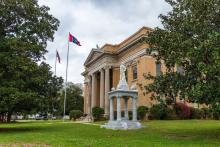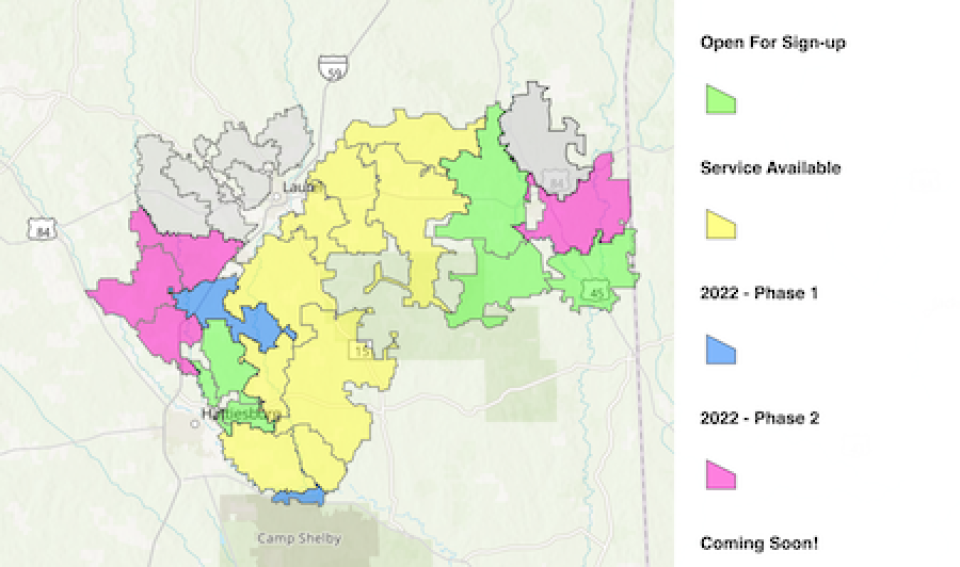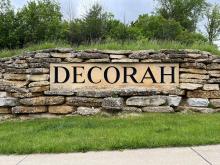
Over the past eighteen months, southeastern-Mississippi based Dixie Electric Power Association (Dixie EPA) has gone from presenting its initial buildout plans for a fiber-to-the-home (FTTH) network, all the way to connecting its 5,000th subscriber. Because of electric cooperatives like Dixie that are getting organized and prioritizing connectivity for their members, Mississippi is likely to become one of the states with the best rural connectivity within the next five years.
Founded in 1938 in Laurel, Mississippi, Dixie EPA’s present-day coverage area stretches across southeastern Mississippi in parts of Covington, Jasper, Jones, Clarke, Wayne, Perry, and Forrest counties. The cooperative provides electric service to 30,000 premises.
In September 2020, about six months into the COVID-19 pandemic, Dixie began pre-registering subscribers for Internet service under the cooperative’s newly-created subsidiary, DE Fastlink. Dixie was part of a collective of electric cooperatives that had just received a recent state appropriation of $65 million in CARES Act funding for rural broadband deployment. The funding was administered under the Mississippi Electric Coop Broadband Covid Grant Program by Mississippi Public Utilities. Dixie planned to match in full its own $3.3 million award, which, according to the terms of the grant, had to be spent by the end of that year.
The cooperative was one of fifteen in Mississippi to receive funding for a buildout. The state was a new leader in supporting cooperatively-run rural broadband; only a select few states decided to spend CARES funding on rural broadband, and Mississippi spent among the most. Of the $75 million in CARES funding it had designated for expanding connectivity, $65 million was awarded to electric cooperatives, while only $10 million was set aside for other types of providers. Of this $10 million, only $1.5 was actually used, because the state received very few grant applications from other types of providers.
A large portion of the reason for this was the initiative taken by the cooperatives themselves. A group of fifteen electric cooperatives collectively proposed a plan to match the funds in full, offering up “maps, budgets, network diagrams, and timetables” to bolster their case. Their proposal would lead to a $130-million investment in rural connectivity across the state.
A Pilot and Beyond

With CARES money it had received to address the broadband gap, Dixie identified an area of particular need for connectivity in southeastern Jones County and northwestern Perry County for a $7.4 million pilot project, $3.3 million of which would be covered by the CARES funding. Dixie’s Communication and Human Resource Manager Lydia Walters outlined the criteria by which the pilot area was chosen: “the area had to be defined by the Federal Communications Commission as an unserved or underserved census block for high-speed Internet service, the project needed to cover more than one county and the build-out for the project needs to come from the same electric substation area.” The cooperative deployed a two-phase pilot project, which included 206 miles of aerial fiber along three stretches of highway, and passed by 1,400 homes and businesses, or an average of about 7 homes and businesses per mile. Dixie’s pilot would end up serving more than 300 members with symmetrical speeds ranging from 100 Megabits per second (Mbps) to 1 Gigabit per second (Gbps).
In December 2020, Dixie was awarded $21.4 million in the Rural Digital Opportunity Fund (RDOF) Phase I Auction to extend its service to over 1,000 additional census blocks. DE Fastlink applied for funding as part of a larger collective of electric cooperatives that received $157 million, the fifth-greatest award in the first phase of the auction. Mississippi had 21 RDOF bidders that will receive up to $495 million total, making it the state to receive the second-greatest allocation of RDOF funding.
By May 2021, Dixie’s pilot project was just a couple months away from completion, the cooperative’s RDOF funding had been unlocked, and its board of directors had approved efforts to expand coverage beyond the pilot area. Dixie was putting together a construction schedule to deploy the 3,000 miles of fiber needed to serve all 30,000 of its electric cooperative members’ homes and businesses, and predicted that this buildout would take between four and five years.

The cooperative connected its thousandth subscriber by September 2021. By January 2022, just a year after receiving approval to expand beyond its service area, DE Fastlink had opened eight phases in its construction plan, was seeing a take rate of over 40 percent, and was aiming to reach 3,000 connections by the end of the year. The cooperative blew past that goal, celebrating its 5,000th subscriber in March of 2022. By its current projections, Dixie will have all of its members connected in 2023.
DE Fastlink offers three residential speed tiers: 100 Mbps for $65/month, 500 Mbps for $75/month, and 1 Gig for $85/month. DE Fastlink also offers three business speed tiers: 100 Mbps for $80/month, 500 Mbps for $90/month, and 1 Gig for $100/month. Neither residential nor business services require contracts or impose data caps, and there is no additional charge for installation.
Big Moves for Mississippi
Dixie’s work reflects a major connectivity shift for Mississippi. In 2019, U.S. News ranked the state 48th on a list that “consider[ed] both the percentage of households with a broadband internet subscription and the share of a state's population with access to high-speed broadband.” With such substantial investment in connectivity by electric cooperatives, however, Mississippi is likely to catapult up this list. The founder of Conexon, a rural Internet service consultancy firm that assisted several of the fifteen Mississippi cooperative grant recipients as they sought funding, has said that “Mississippi is leading the nation when it comes to investment in broadband.” The state, which just recently created the Office of Broadband Expansion and Accessibility to facilitate the distribution of hundreds of millions in federal COVID relief funding, is poised to join states like Missouri and Arkansas, which have made huge broadband strides in rural areas despite having been named among the least connected states in recent years.
Header image courtesy of CRobertson on iStock







